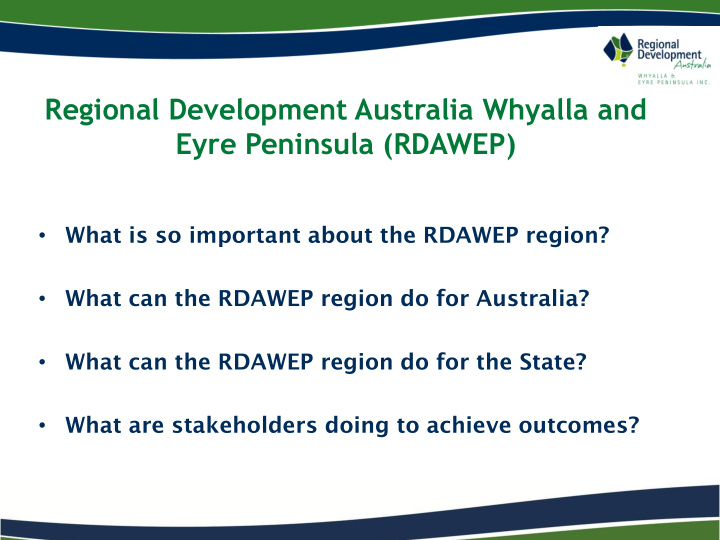



Regional Development Australia Whyalla and Eyre Peninsula (RDAWEP) What is so important about the RDAWEP region? • What can the RDAWEP region do for Australia? • What can the RDAWEP region do for the State? • What are stakeholders doing to achieve outcomes? •
Current Planning Regime Australian Government Key Determinants of Regional • Growth – recognised by COAG. South Australian Government Plans – State and • Region. RDAWEP Regional Plan • NRM Board Plans – AW and EP Regions • EPLGA Regional Plans – Management and Transport • Local Council Strategic Plans x 11 • Local Council Health Plans x 4 •
Regional Strategic Plan Framework AUSTRALIAN GOVERNMENT: KEY LOCAL GOVERNMENT, NRM, SOUTH AUSTRALIAN KEY PROJECTS OF STAKEHOLDER DETERMINANTS OF REGIONAL RDAWEP, EPLGA and Other GOVERNMENT PRIORITIES ORGANISATIONS GROWTH PLANNING PRIORITIES Priorities from Stakeholder Projects Aligned with Key Human Capital Development 7 Strategic Priorities Strategic Plans Determinants Aligned with Australian and Projects Aligned with Grant Sustainable Economic Growth 10 Economic Priorities State Government Priorities Funding Programs South Australian Strategic Project Progress Assessed for Sustainable Environmental Growth Plan Targets Grant Funding Readiness Aligned with Australian Sustainable Social Growth Government Priorities Access to Markets Comparative Advantage and Business Competitiveness
What is so important about the region? Current status, issues, advantages and opportunities. • Evidence based data is essential. • Main Source: ABS Census Data. • 2011 Census Data now outdated. • Major upgrade in 2017, using 2016 Census data. • DATA WEAKNESS: Reliable Economic Data. • New data has been commissioned. •
New Data Prepared by EconSearch EconSearch produces financial models for DPC and • PIRSA. Data commissioned by EPLGA and RDAWEP. • 2012-13 Data for Region and each Council. • Available at 20 and 78 industry level. • Data packs to be provided to each Council. • Data will be updated and provided annually. • Data presently being analysed. •
Region and LGA Contribution to GRP and GSP. % Regional % State Contribution to Contribution to Contribution to AREA Population Population Population GRP ($m) GRP (%) GSP (%) Whyalla 22,088 39.2 1.38 1,472 42.7 1.55 Port Lincoln 14,086 25.0 0.88 839 24.3 0.88 Ceduna 3,480 6.2 0.22 252 7.3 0.26 Cleve 1,733 3.1 0.11 121 3.5 0.13 Elliston 1,046 1.9 0.06 76 2.2 0.08 Franklin Harbour 1,273 2.3 0.08 61 1.8 0.06 Kimba 1,088 1.9 0.07 82 2.4 0.09 Lower EP 4,916 8.7 0.31 195 5.7 0.21 Streaky Bay 2,012 3.7 0.13 101 2.9 0.11 Tumby Bay 2,586 4.6 0.16 149 4.3 0.16 Wudinna 1,253 2.2 0.08 99 2.9 1.04 REGION 56,396 100.0 3.53 3,446 100.0 3.62
Production Context On average, the region produces about 40% of South • Australia’s wheat, 24% of barley, and 22% of canola. Approximately 97% of the region’s grain crop is exported. • On average, the region produces 100% of SA’s Southern • Bluefin Tuna, 100% of marine finfish, 97% of the State’s oysters, 92% of mussels, and about 62% of abalone. The regional contribution to South Australia’s mining • sector has yet to be calculated, but with 79.2% mining industry growth since 2001 and numerous projects close to operation, this contribution is anticipated to escalate in future years.
Regional Export Data 2012-13 Exports from the region were valued at $3.745 billion. • The major export industry sectors were: • Grains – 19.1% of total exports, valued at $716 million, • Iron and Steel Production – 16.9%, $633 million, • Iron and Non-ferrous Ore Mining – 13.3%, $496 million. • Other key export sectors were: • Sheep - 4.4%, valued at $163 million, • Residential building construction - 3.9%, $146 million, • Aquaculture - 3.2%, $121 million, • Processed seafood products - 3.2%, $120 million, and • Road transport - 2.9%, valued at $110 million. • In addition to exports from the region, the value of products and • services traded internally between LGAs was $1.23 billion.
Recommend
More recommend